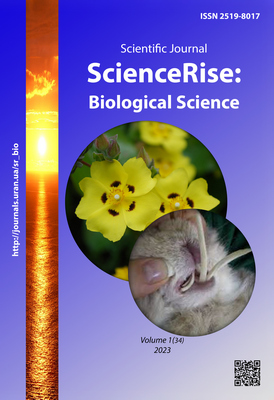II. Morphometry of wings of worker bees of the subspecies Apis mellifera mellifera L. (Polissya population of Zhytomyr region)
DOI:
https://doi.org/10.15587/2519-8025.2023.275588Keywords:
Morphometry of wings, classification of worker bees, discriminant analysisAbstract
The uncontrolled spread of the subspecies A. m. carnica, A. m. ligustica, and A. m. caucasica has led to a reduction in the areas of pure "dark forest bees" populations belonging to the subspecies A. m. mellifera in their natural habitats within Ukraine. Due to the need to use dark forest bees in breeding, it became necessary to identify the locations of individual populations of bees belonging to the A. m. mellifera subspecies.
The purpose of the work is to create an accessible and at the same time complete methodology for classifying bee wing phenotypes, which would make it possible to determine the probable breed of worker bees, the type and degree of hybridization of the main breed with impurities, and to identify "purebred" bee families by the wing phenotype suitable for further breeding.
Material and methods of research: Using discriminant analysis of data, at the first stage of the study, 1500 wings of bee families were classified using 8 features: Ci, Dbi, Disc.sh, Pci, Ri, Сі.3, Сі.2, Сi.2.1, for which there was preliminary information about the possible belonging of the wing phenotype to the subspecies A. m. mellifera or its hybrids. At the second stage, additional 1212 wings of bee colonies were studied, about which there were doubts about their breed.
Results of research and discussion: The wings are reliably divided into four clusters, indicating the presence of four sufficiently distinct groups among the studied wings in terms of phenotype.
Conclusions and prospects for further research: A classification model has been created that allows for effective discrimination of the wings of working bees of bee colonies in Ukraine, the subspecies A. m. mellifera. Phenotypic values of indices of four Polissia micro-populations of bees, used as reference standards for possible hybridization detection, have been established, which can serve as standards in future research. Four colonies have been found, whose queens produce bees of the A. m. mellifera type of the Polissia population, and three colonies whose queens produce bees of the A. m. macedonica hybrid and can be used for further selection work
References
- Halatiuk, O. Ye., Petrenko, S. O. (2020). Bdzhilnytstvo ta profilaktyka khvorob. Odesa: Astroprynt, 324.
- Keller, E. M., Harris, I., Cross, P. (2014). Identifying suitable queen rearing sites of Apis mellifera mellifera at a regional scale using morphometrics. Journal of Apicultural Research, 53(2), 279–287. doi: https://doi.org/10.3896/ibra.1.53.2.09
- Groeneveld, L. F., Kirkerud, L. A., Dahle, B., Sunding, M., Flobakk, M., Kjos, M., Henriques, D., Pinto, M. A., Berg, P. (2020). Conservation of the dark bee (Apis mellifera mellifera): Estimating C-lineage introgression in Nordic breeding stocks. Acta Agriculturae Scandinavica, Section A – Animal Science, 69 (3), 157–168. doi: https://doi.org/10.1080/09064702.2020.1770327
- Oleksa, A., Chybicki, I., Tofilski, A., Burczyk, J. (2011). Nuclear and mitochondrial patterns of introgression into native dark bees (Apis mellifera mellifera) in Poland. Journal of Apicultural Research, 50 (2), 116–129. doi: https://doi.org/10.3896/ibra.1.50.2.03
- Ruttner, F. (1988). Zuchttechnik und Zuchtauslese bei der Biene. Ehrenwirth-Verlag, 138.
- Meixner, M. D., Worobik, M., Wilde, J., Fuchs, S., Koeniger, N. (2007). Apismellifera melliferain eastern Europe – morphometric variation and determination of its range limits. Apidologie, 38 (2), 191–197. doi: https://doi.org/10.1051/apido:2006068
- Yarovets, V., Babenko, V., Halatiuk, O., Strilchuk, M., & Mozharovskyi, I. (2022). Morphometry of bees wings of the southeastrn region of polisya (Zhytomyr region). Scientific and production journal “Beekeeping of Ukraine,” 1 (8), 72–76. doi: https://doi.org/10.46913/beekeepingjournal.2022.8.11
- TpsDig 2. Available at: https://ru.freedownloadmanager.org/Windows-PC/tpsDig2.html
- Yarovets, V. I., Babenko, V. V., Galatiuk, O. Ie. (2022). Morphometry of bee wings on eight signs indices: Ci, Dbi, Disc.sh, Pci, Ri, Ci.2, Ci.2.1, Ci.3. Scientific and production journal “Beekeeping of Ukraine,” 1 (8), 65–71. doi: https://doi.org/10.46913/beekeepingjournal.2022.8.10
- StatSoft (2001). Mоscow. Available at: http://www.StatSoft.ru/home/textbook/default.htm
- Avetisian, G. A. (1983). Razvedenie i soderzhanie pchel. Moscow: Izdanie «Kolos», 271.
- Polishchuk, V. P. (2001). Bdzhilnytstvo. Kyiv: Vydavnytstvo «Ukrainskyi pasichnyk», 296.
- Yarovets, V., Babenko, V., Mozharovskyi, I., Sakara, P. (2021). Morfometriia kryl deiakykh linii porody «Sira hirska kavkazska». Ukrainskyi pasichnyk, 6, 4.
- Ruttner, F., Tassencourt, L., Louveaux, J. (1978). Biometrical-statistical analysis of the geographic variability of apis mellifera L. I. Material and Methods. Apidologie, 9 (4), 363–381. doi: https://doi.org/10.1051/apido:19780408
Downloads
Published
How to Cite
Issue
Section
License
Copyright (c) 2023 Oleksandr Galatyuk, Volodymyr Yarovets, Volodymyr Babenko, Volodymyr Cherevatov , Bogdan Gutyj, Andrii Grigorenko, Mykhailo Strilchuk, Ihor Stolyar

This work is licensed under a Creative Commons Attribution 4.0 International License.
Our journal abides by the Creative Commons CC BY copyright rights and permissions for open access journals.
Authors, who are published in this journal, agree to the following conditions:
1. The authors reserve the right to authorship of the work and pass the first publication right of this work to the journal under the terms of a Creative Commons CC BY, which allows others to freely distribute the published research with the obligatory reference to the authors of the original work and the first publication of the work in this journal.
2. The authors have the right to conclude separate supplement agreements that relate to non-exclusive work distribution in the form in which it has been published by the journal (for example, to upload the work to the online storage of the journal or publish it as part of a monograph), provided that the reference to the first publication of the work in this journal is included.









